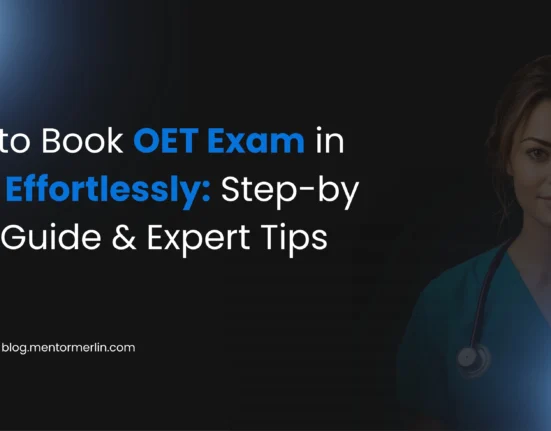Introduction
OET Listening subtest is the essential part of the Occupational English Test for healthcare professionals . It involves three parts: audio recordings of healthcare conversations, talks, and interviews. While the test may seem challenging, leveraging the benefits of OET listening transcripts can significantly enhance your preparation and boost your performance. In this blog post, we will explore the importance of transcripts and provide practical techniques to use them effectively in your OET Listening practice.
The OET Listening Sub-Test: A Quick Overview
Before we delve into its importance, let’s briefly recap the OET Listening sub-test. With three parts encompassing diverse healthcare scenarios, you listen to the audio only once and are required to select your answers as you listen. You have three parts to listening: Part A, Part B, and Part C, each with different types of audio.
What is the significance of OET Listening transcripts?
They are written copies of the audios in the test and play a vital role in your preparation. Reviewing them after a practice test allows you to cross-check your answers and identify any mistakes, guiding your study effectively.
As they provide written copies of the audio recordings, reviewing them after practice helps you check answers, identify mistakes, and guide your study. They can help you identify areas for improvement and enhance your listening skills. It reveals areas of difficulty, such as missing key information or misunderstanding conversations. Analyzing patterns helps you focus on improving comprehension and understanding different accents and speeds.
How can they help you identify areas for improvement and enhance your listening skills?
How do they help with vocabulary and grammar?
They serve as a treasure trove of medical words, phrases, and complex grammar used in healthcare. Read them attentively, noting unfamiliar terms, and expand your vocabulary by exploring their meanings. This exercise also familiarizes you with OET’s language style, improving your language proficiency. They also introduce new medical words, phrases, and complex grammar. Studying them carefully and using unfamiliar terms in your speech and writing enhances your language proficiency.
How do transcripts contribute to better comprehension of OET Listening content?
Using them repeatedly, along with listening to the audio, enhances your comprehension skills. This exposure helps you become more acquainted with diverse accents, pronunciations, and speech patterns, leading to significant improvements in your listening abilities.
Top Techniques with Transcripts
Leveraging OET Listening transcripts can significantly boost your preparation. Now, we’ll explore simple and effective techniques for practice, helping you sharpen your listening skills and excel in the test.
- Post-Test Analysis: After each listening task, check your answers on the scripts to identify areas for improvement and create a focused study plan.
- Shadowing Technique: Listen to the audio while reading the script to master pronunciation and flow, mimicking native speakers’ speech patterns.
- Gap-Fill Exercises: Remove words from the script and try to fill them in while listening to enhance your listening and understanding skills.
- Repetition and Consistency: Regularly practice with these scripts to reinforce learning and familiarize yourself with different accents and medical terminologies.
- Vocabulary Enrichment: Learn new medical words from them and use them in your speaking and writing to improve your language proficiency.
For OET Related Queries – Chat Now

Maximizing OET Listening Practice with organized transcript activates
- Prepare to Listen: Before listening to the audio, familiarize yourself with the question sheet from a sample test. Read the instructions, context statements, and questions to anticipate the type of language you’ll encounter during the test.
- Answer Attempt: Engage with the recording. Listen to the recording and attempt to answer the questions without referring to the script yet. This step tests your initial listening skills.
- Transcript Analysis: Now, retrieve the script and read it carefully while listening to the recording. Pay close attention to the parts of the conversation relevant to the questions. Simultaneously, listen and read.
- Answer Search: Compare your initial answers with the information in the transcript (not the answer key!). Identify any mistakes and understand why you missed the correct answers during your first attempt.
- Answer Check: Verify your responses. Refer to the official answer key and double-check your responses against the correct answers. This step clarifies any remaining doubts and reinforces your understanding.
- Identify Difficult Sections: Highlight any sections in them that proved challenging during the first or second listen. These may include complex ideas, fast speech, unfamiliar vocabulary, or difficult accents.
- Focused Listening: Replay the difficult sections multiple times, following along with them. This focused practice helps you grow more comfortable with the challenging aspects over time.
- Reflection: Reflect on what made certain parts difficult—was it the speed, accent, vocabulary, or complexity of the information? Understanding these patterns empowers you to tailor your future practice.
Join Mentor Merlin to learn about OET Listening. Check out more on transcripts.
Conclusion
OET Listening transcripts serve as invaluable tools in your test preparation, offering multiple benefits for improving listening skills and overall performance. By incorporating post-test analysis, shadowing techniques, and gap-fill exercises into your study routine, you can effectively enhance your listening comprehension, pronunciation, and understanding of medical terminology. Remember, repetition and vocabulary enrichment are keys to mastering OET Listening. Embrace these techniques, and with dedicated practice, you will excel in the OET Listening sub-test, laying a strong foundation for your success as a competent healthcare professional. Happy practicing!
Transform your OET Writing skills and tackle your uncertainty!














Leave feedback about this